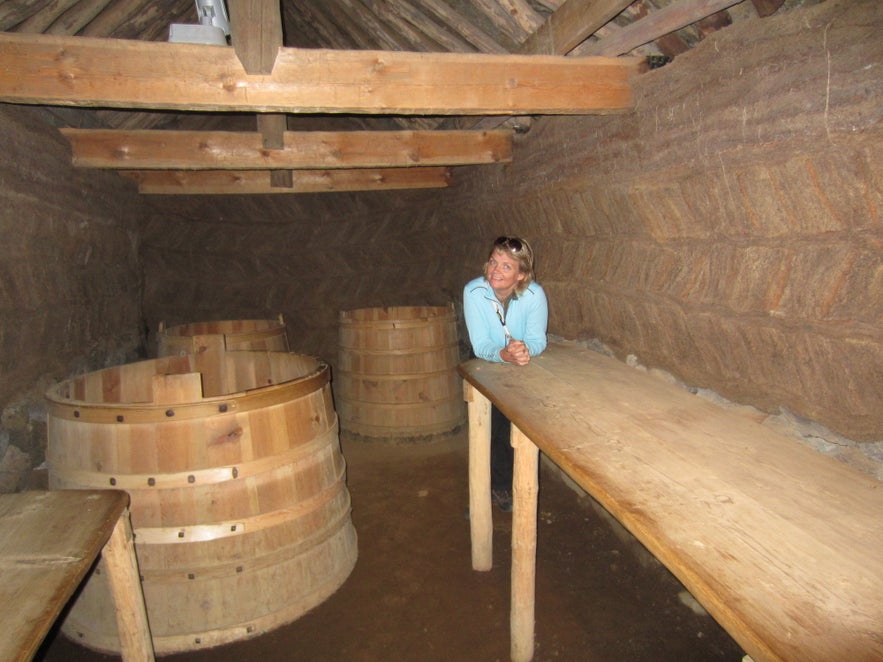
Icelandic turf houses
I am a huge fan of old traditions in Iceland and have often wondered and admired how our ancestors lived all these long periods of dark ages, with eruptions and cold weather. Through the centuries the history of building houses in Iceland deals mainly with various types of turf farmhouse.
Before concrete took over around 1900, turf, stone and wood were the main construction materials used here. The timber was either driftwood or imported wood. Houses built from these materials are rather short-lived so that there are not many examples left.
With the aid of literary sources and most important, through archaeological research, scientists have managed to create a good overview over the development of the turf-house.
In many countries, old castles, churches and forts are among the favourite tourist sites. We don't have any of those here in Iceland. The oldest houses in Reykjavík date from the 18th century, but elsewhere in the country there are some houses that are much older, like for instance parts of the buildings at Keldur in South-Iceland, from the 13th century.
The development can be divided into three main periods: first the period of the long-house, or skáli, then the passage-house, and finally the period of the gabled house. The first settlers brought with them the building tradition from their homeland, which in most cases was the west coast of Norway.
Long-house were typical to this first period can be described as a large, oblong house, rather narrow. Lack of firewood and timber is probably the main reason why the passage-house made of turf gradually took over from the long-house. This sort of house was a complex of several small houses that were joined together by one passage. Each room had its function.
Gabled houses appeared towards the end of the 18th century. They became quite popular, mainly on aesthetic grounds. Main difference between these and their predecessor’s lies in the wooden front gables that give the farms a statelier look. The roofs had to be rather steep so that rainwater would drain easily.
The museum farm, Glaumbær in North-Iceland is a good example of such a house. There, storehouses and two guest-rooms are at the front, but the main complex of rooms is still at the back, where it’s warmer. Many of the turf-farmhouses that have been preserved have been turned into folk-museums. Whoever wants to learn about housing and the way people lived in the old days here in Iceland should visit one of these museums.
Only 75 km from Egils Guesthouse is the Museum at Árbær in Reykjavík. Very interesting museum if one wants to study the various types of old houses we have in Iceland.
其他有意思的博客
冰岛最浪漫的角落
对于很多人,遥远的冰岛有着世界尽头的神秘,有着区别于巴黎、马尔代夫、自成一体的浪漫。没有埃菲尔铁塔和蒂凡尼,没有热带沙滩,而是在冰川、火山、苔藓地的背景下蜜月旅拍、婚拍,甚至举办一场冰岛婚礼。来冰岛旅行,多是要跨千山万水、飞跃大洋大陆,很有一点“万水千山陪你走过”的史诗感。难怪很多人说,光是冰岛二字,就足够浪漫了。 冰岛虽然不大,但是地貌极其丰富,不同的自然景观自然有不同的气质。这一篇,就挑阅读更多从极光观测到摄影-到底该不该来冰岛看极光
很多朋友都想来冰岛看极光,但是冰岛到底适不适合看极光呢?几月、什么季节能看到极光?是不是一定要参加北极光旅行团?如何能拍摄出美丽的极光照片呢?在冰岛住了好几年了,从刚开始逢极光必出门,到如今家里阳台就能看极光,我对在冰岛看极光的了解和经验,也算得上大半个专家了,且听我娓娓道来吧。 到底该不该来冰岛看极光呢?最坦诚的答案是,不要只为了看极光而看极光。 极光原理 太阳活动→太阅读更多
迷失冰岛的米湖游览推荐|不只有温泉的地热宝藏区
我在冬夏秋均到访过米湖,看过米湖的不同面。一直以来,米湖到底值不值得去是很多游客争论的问题。有些人觉得这里是来冰岛旅行的必去目的地,有些人则说米湖“太丑了”,连照片都不想多拍几张。那米湖到底值不值得来呢?到底怎么玩呢? 米湖的风景 北部的米湖,因地理位置相距首都雷克雅未克略远,很多来冰岛的短途游客选择放弃,其实米湖应该是和黄金圈、南岸沿线至冰湖齐名的冰岛景色,这里冷热相融,可谓最冰岛,尤其阅读更多

将冰岛最大的旅行平台下载到您的手机中,一站式管理您的整个行程
使用手机摄像头扫描此二维码,然后点击显示的链接,将冰岛最大的旅行平台添加到您的手机中。输入您的电话号码或电子邮件地址,以接收包含下载链接的短信或电子邮件。



















